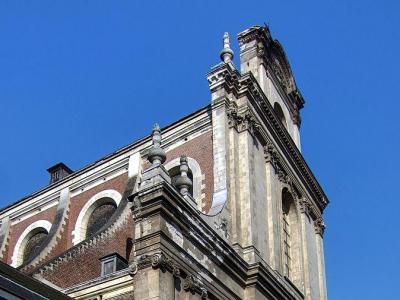
Église Saint-Étienne (Church of Saint-Étienne), Lille
The Church of Saint-Étienne, located in Lille, is a significant Roman Catholic church with the designation of Historic Monument since 1987. Dedicated to Saint Stephen, it stands as one of the largest Jesuit-built churches in France.
The church originated as a Jesuit chapel, part of their broader presence in Lille since 1562. Constructed initially between 1605 and 1610, it suffered destruction by fire in 1740. François-Joseph Gombert, following Dominique Delesalle’s plans, led its reconstruction from 1743, overcoming interruptions by military conflicts, and completing it in 1748. The building was consecrated in 1750, and after the expulsion of the Jesuits from France in 1765, it served as a chapel for the local college and military hospital.
Architecturally, the church displays a classical Roman Baroque style, characterized by a 29-meter-high stone façade, a 57-meter bell tower with a campanile adjacent to the choir, and an interior layout based on a Latin cross. The interior spans 61 meters in length and includes a nave with seven bays, side chapels, and a choir ending in a semi-circular apse. The ceilings over the choir and aisles feature ogive vaulting, while the nave boasts a barrel vault. The flooring of black and white marble originates from the earlier chapel, and its stained glass windows, crafted by Charles Gaudelet between 1854 and 1862, add a vivid touch.
Notable furnishings include a pulpit sculpted by François Rude between 1825 and 1828, depicting an angel and cherubs above figures of Faith and Hope, and an organ built in 1840 by Daublaine Callinet, subsequently modified to include 39 stops, three keyboards, and pedals. The church, through its historical layers and artistic contributions, continues to be a central spiritual and cultural landmark in Lille.
The church originated as a Jesuit chapel, part of their broader presence in Lille since 1562. Constructed initially between 1605 and 1610, it suffered destruction by fire in 1740. François-Joseph Gombert, following Dominique Delesalle’s plans, led its reconstruction from 1743, overcoming interruptions by military conflicts, and completing it in 1748. The building was consecrated in 1750, and after the expulsion of the Jesuits from France in 1765, it served as a chapel for the local college and military hospital.
Architecturally, the church displays a classical Roman Baroque style, characterized by a 29-meter-high stone façade, a 57-meter bell tower with a campanile adjacent to the choir, and an interior layout based on a Latin cross. The interior spans 61 meters in length and includes a nave with seven bays, side chapels, and a choir ending in a semi-circular apse. The ceilings over the choir and aisles feature ogive vaulting, while the nave boasts a barrel vault. The flooring of black and white marble originates from the earlier chapel, and its stained glass windows, crafted by Charles Gaudelet between 1854 and 1862, add a vivid touch.
Notable furnishings include a pulpit sculpted by François Rude between 1825 and 1828, depicting an angel and cherubs above figures of Faith and Hope, and an organ built in 1840 by Daublaine Callinet, subsequently modified to include 39 stops, three keyboards, and pedals. The church, through its historical layers and artistic contributions, continues to be a central spiritual and cultural landmark in Lille.
Want to visit this sight? Check out these Self-Guided Walking Tours in Lille. Alternatively, you can download the mobile app "GPSmyCity: Walks in 1K+ Cities" from Apple App Store or Google Play Store. The app turns your mobile device to a personal tour guide and it works offline, so no data plan is needed when traveling abroad.
Église Saint-Étienne (Church of Saint-Étienne) on Map
Sight Name: Église Saint-Étienne (Church of Saint-Étienne)
Sight Location: Lille, France (See walking tours in Lille)
Sight Type: Religious
Sight Location: Lille, France (See walking tours in Lille)
Sight Type: Religious
Walking Tours in Lille, France
Create Your Own Walk in Lille
Creating your own self-guided walk in Lille is easy and fun. Choose the city attractions that you want to see and a walk route map will be created just for you. You can even set your hotel as the start point of the walk.
Lille's Historical Buildings Tour
Historically, Lille's architecture differs from that of other French cities. Prior to being invaded by Louis XIV in 1667, Lille was Flemish, which is evident in its red-brick and other structures, quite uncommon for the rest of France.
Among many things, Lille is reputed for its fabulous historic center, abounding in time-honored buildings, palaces, and churches, offering a great deal of... view more
Tour Duration: 2 Hour(s)
Travel Distance: 3.7 Km or 2.3 Miles
Among many things, Lille is reputed for its fabulous historic center, abounding in time-honored buildings, palaces, and churches, offering a great deal of... view more
Tour Duration: 2 Hour(s)
Travel Distance: 3.7 Km or 2.3 Miles
Lille Introduction Walking Tour
Nicknamed in France the "Capital of Flanders", Lille and its surroundings belong to the historical region of Romance Flanders. Legend has it that in 620 AD, Salvaert, Prince of Dijon, passed through the region with his pregnant wife when he was attacked and killed by the local lord Phinaert The Giant. Years later, his son Lyderic avenged his father by killing the Giant and founded the... view more
Tour Duration: 2 Hour(s)
Travel Distance: 4.0 Km or 2.5 Miles
Tour Duration: 2 Hour(s)
Travel Distance: 4.0 Km or 2.5 Miles


